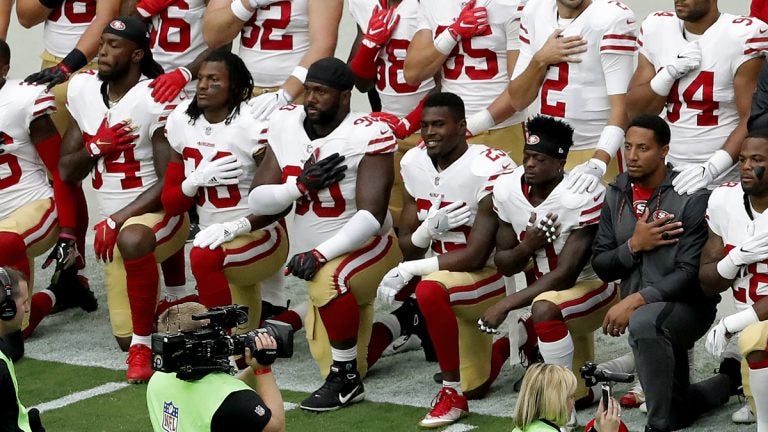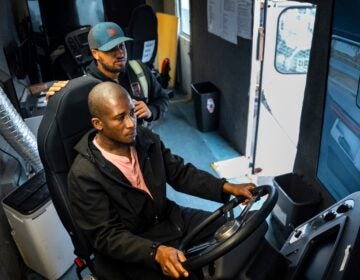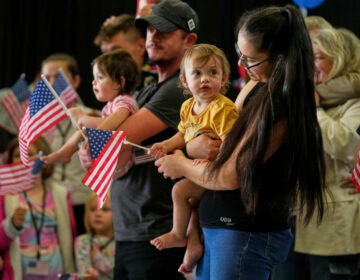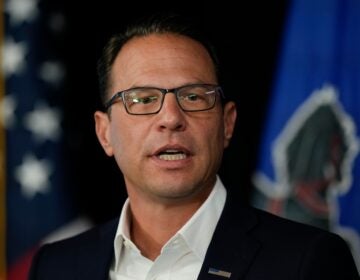Americans must decide who we stand with and what we kneel for
Does standing up for racial justice, economic equity, compassion, or truth demand, at crucial moments, that we plant one shoe on the earth and lower the other knee?

Members of the San Francisco 49ers kneel during the national anthem as others stand prior to an NFL football game against the Arizona Cardinals, Sunday, Oct. 1, 2017, in Glendale, Ariz. (Matt York/AP Photo)
There was a moment during recent High Holiday services at my Reconstructionist synagogue when nearly everyone in the place took a knee.
Before we did it, the rabbi did what rabbis do: He offered context and kavannah (intention). He told us that the Hebrew word for “blessing,” berakah, shares a root with the words for “knee,” berek, and “kneel,” barak. And the prayer we were about to utter called for a bendy bit of choreography — a gentle half-squat followed by a tilt forward, coming upright on the word Adonai, or God.
The rabbi’s teaching stood out to me not just because I’m that kind of word geek, but because, for one-fourth of this year, my knee — a body part I rarely thought about before June 12 — could not bend.
That day, I broke my kneecap in a fall from a loft bed onto a wooden floor. For two weeks before surgery and 11 weeks afterward, I wore a hip-to-ankle brace — first, a no-frills version from the emergency department at Yale New Haven Hospital, then a $700 device with wide Velcro straps and an adjustable hinge locked at 180 degrees.
Initially, the immobilizer prevented the pieces of my fractured kneecap from drifting further apart. And after my surgeon had whip-stitched the crumbly chunks back together, the brace held his handiwork in stasis until the bone could fuse.
Turns out it’s a handicap, having a leg that doesn’t bend. Try going upstairs without flexing your knee. Now sit down — at the dinner table, at the movies, on the No. 23 bus. Putting on underwear called for absurd contortions. Putting on a sock was out of the question. So was gardening, sponging the bathroom floor, picking up the grape I’d dropped, leaning over to sweep kitchen detritus into the dustpan, or fetching the newspaper from under the porch steps.
I couldn’t spoon my sweetheart. I couldn’t crouch to pet the cat. I couldn’t dance. And when I attended Shabbat services a few times over the course of the summer, and it came time for the Aleynu, the redemption prayer that includes that customary bend-and-bow, all I could manage was a stiff-legged bob forward.
I began referring to my brace as “leg jail.” And even though my physical therapist and I were working hard (I’m talking hot tears, clenched-jaw grimaces, and the occasional, involuntary howl) to teach my knee how to act like a knee again, leg jail remained locked until the PT was able to lean in and achieve the magic 90 degrees of flexion.
That night, Aug. 29, I celebrated with my partner, our daughter, and our housemates: a homemade chocolate cake I cut into moist, right-angled shapes. And then, just as I was regaining FROM (“full range of motion” in PT jargon), professional athletes all over the country started taking a knee.
It started last year, you may recall, with former San Francisco 49er Colin Kaepernick, who knelt during the national anthem to raise awareness about racial injustice. But it really blasted off last month, after President Donald Trump chided such protests while stumping in Alabama for incumbent Republican Senator Luther Strange.
Trump’s candidate lost, but his remarks (“Wouldn’t you love to see one of these NFL owners, when somebody disrespects our flag, to say, ‘Get that son of a bitch off the field right now. Out!'”) spurred players from New Orleans to New England to follow Kaepernick’s lead.
Trump, who rarely has a thought he doesn’t tweet, lobbed back: “Very important that NFL players STAND tomorrow, and always, for the playing of our National Anthem. Respect our Flag and our Country!”
Just last weekend, Vice President Mike Pence made a hasty exit from a Colts/49ers game after some San Francisco players knelt during the anthem.
What does it mean to stand up for something, or to kneel down? Over the centuries, bowing has meant homage, subservience, gratitude, humility. Devout Muslims kneel toward Mecca five times daily. Enslaved people have bent their backs, under duress, to the whip. We kneel in desperation, in terror, and in prayer.
Kneeling makes us smaller. It brings us to the ground, just a film of cloth between skin and gritty sidewalk, or Astroturf, or floor. Suddenly, we are the height of a child, viewing the world as we used to: adults looming over us like gods, the sky a far-off scrim of blue.
Maybe we’re not as big as we think we are.
To bow completely, flexing both knees as far as anatomy allows, curling our backs and touching forehead to earth, is a dramatic shift in posture and perspective. But even a partial bend — what so many athletes continue to do, in defiance of Trump’s bluster — jars what we see, and how others see us.
Babies have no trouble bending. Their kneecaps are cartilage until they’re 3. We tend to stiffen as we age, literally and metaphorically. It takes work to remain flexible, not only after injury or surgery, but against the routine hardening of principle and circumstance.
This is a time of turmoil, when Americans must decide, again and anew, for what and with whom we will stand. Can we, knowing what we know, lift our gaze to a bronzed, pedestaled figure of Confederate Gen. Robert E. Lee or a stained-glass image of John C. Calhoun, a 19th-century white supremacist who also happened to be vice president? Can we truly remain erect, hands on hearts, for an anthem that smugly declares our country to be “the land of the free-eee and the home of the brave?”
Can we do that when we have a president who will never nab any awards for bravery, whose outsized ego prods him to behave like a schoolyard bully, who bends to nothing except the god of self-aggrandizement?
Or, in these frightening times, does standing up — for racial justice, for economic equity, for compassion, for truth — demand, at crucial moments, that we plant one shoe on the earth and lower the other knee until it kisses ground? A gesture of defiance, a voluntary crouch that is not about acquiescing to anyone or any thing, but its brave and joyful opposite.
They are joined at the root: Berakah, berek, barak. We bend our knees because we can, because we are not shackled and do not want anyone to be shackled, anywhere, ever again. Because we believe that freedom — physical and psychic — is our blessing. We enact it with our bodies: arms linked, all together, now, because it is the only way to move toward justice.
WHYY is your source for fact-based, in-depth journalism and information. As a nonprofit organization, we rely on financial support from readers like you. Please give today.




